Revival of the fastest
2009 Circuit Revival Meeting report
Author
- Mattijs Diepraam (words & pictures)
Date
- September 25, 2009
Related articles
- Goodwood - A delightful antidote, 2001 Circuit Revival Meeting report, by Mattijs Diepraam/Frank van de Velde
- Goodwood - Continental Grand Prix team in search for British excellence, a spoof period report on the 2003 Revival Meeting, by Mattijs Diepraam
- Goodwood - Photographic impressions of the 2003 Revival Meeting, Friday's gallery, by Frank van de Velde/Mattijs Diepraam/Jeroen Bruintjes
- Goodwood - Photographic impressions of the 2003 Revival Meeting, Saturday's gallery, by Frank van de Velde/Mattijs Diepraam
- Goodwood - Photographic impressions of the 2003 Revival Meeting, Sunday's gallery, by Frank van de Velde/Mattijs Diepraam
- Goodwood - Indian summer for historic motor cars, 2005 Circuit Revival Meeting report, by Mattijs Diepraam
- Goodwood - Thrills and spins in Revival spectacle, 2007 Circuit Revival Meeting report, by Mattijs Diepraam
- Goodwood - Happy Anniversary, 2008 Circuit Revival Meeting report, by Mattijs Diepraam/Maarten Hoeben
- Goodwood - Row, row, row your boat, 2011 Circuit Revival Meeting report, by Mattijs Diepraam
- Goodwood - The roots deliver the goods, 2012 Circuit Revival Meeting report, by Mattijs Diepraam
- Goodwood - Keeping its core intact, 2013 Circuit Revival Meeting report, by Mattijs Diepraam
- Goodwood - Being part of it, 2014 Circuit Revival Meeting report, by Mattijs Diepraam
- Goodwood - The cars are the stars, with stars in the cars, 2015 Circuit Revival Meeting report, by Mattijs Diepraam
- Goodwood - Don't rain on my parade, 2017 Goodwood Revival report, by Mattijs Diepraam
- Goodwood - Sunny days are here again, 2018 Goodwood Revival report, by Mattijs Diepraam
- Goodwood - Hot times, summer on the circuit, 2019 Goodwood Revival report, by Mattijs Diepraam
- Goodwood - Dash and splash, 2025 Goodwood Revival report, by Mattijs Diepraam
Who?Patrick Blakeney-Edwards What?Frazer Nash TT Replica Where?Goodwood When?2009 Goodwood Revival (September 20, 2009) |
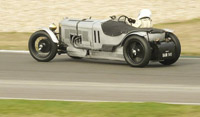 |
Why?
Delicate British early-autumn weather, atmosphere oozing from every corner of the grandstands and paddock, and not a single dull race. Not a lot of damage done either, in the bodywork category at least, as the gentlemen and occasional lady driver focused on bringing their mounts home while putting on a good show.
Until the final race of the weekend, that is, when a pack of wolves was set free in the ultra-fast Whitsun Trophy for big-banger sportscars. It all went wrong at the start when Paul Knapfield’s Lola T70 suddenly veered left to collect Marshall Bailey’s similar car and Joaquin Folch’s GT40. The ensuing safety-car period reduced the event to a sprint race won by Julian Bronson’s McLaren M1B, having fended off the advances of the two T70s of Jon Minshaw and Andrew Smith. Fourth-place man Andrew Newall in the Ford GT40 Roadster was the early leader before he was swamped by the Chevy-engined mob.
Paddock, practice and race pictures of the Whitsun Trophy
Undoubtedly, the most exciting race of the weekend came on early Sunday, making the late-comers eternally regret their morning sleep-in. Patrick Blakeney-Edwards singlehandedly – although sometimes he must have wished he had three hands! – turned the race into a right cracker, performing a ‘two-stop strategy’ for his Frazer Nash TT Replica that almost paid off. Consummately the fastest car in the field, the Frazer Nash had to fight cooling problems at first, Blakeney-Edwards having to pit for water. Not being allowed back on the track at once because of the traffic, he found himself back in seventh place. Now probably steaming more than his car, he fought his way back into the lead and seemed set for victory when his main rival Jeremy Brewster in the Lea Francis Hyper had to abandon the race.
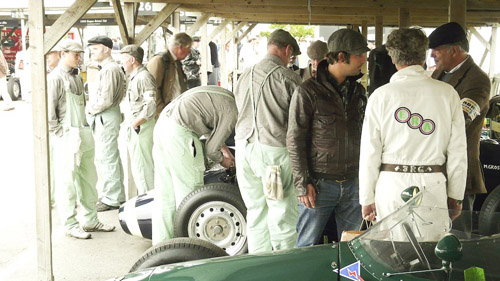
But then Blakeney-Edwards was in again for another topping-up. This left Nick Mason’s Aston Martin Ulster in the lead but since the Frazer Nash was capable of lapping five seconds faster it seemed like a foregone conclusion that the Pink Floyd drummer would have to hand the lead back again. It didn’t happen. Instead, Blakeney-Edwards’s pace slowed again and we saw him frantically trying to increase his dropping fuel pressure while fighting to stay on the road. His hand-pumping actions helped him enough to cross the line but steady Mason was the winner.
Race pictures of the Brooklands Trophy
Earlier, Blakeney-Edwards went to the fore in the Madgwick Cup for smaller post-war sportscars but while he jumped in the lead from the startline in his Frazer Nash Le Mans Replica he was soon overhauled by the faster Maserati A6GCS of Lukas Hüni, the Swiss proceeding to an easy victory. There was plenty of action behind him, however. Adrian Hall and Nick Wigley touched into Madgwick before Hall’s Lotus 10 fell off at St. Mary’s. This left Wigley’s Tojeiro to reel in – and surge past – Blakeney-Edwards. The show man wasn’t about to give up, though, when two laps from the end he used the traffic to his advantage to fly past on the straight towards Fordwater, even taking time out to wave to his opponent! But Wigley was back into second only moments later and was to stay there to the end of the race.
Practice and race pictures of the Madgwick Cup
In the Richmond Trophy for 2.5-litre front-engined Grand Prix cars, we saw a titanic lead battle between Richard Attwood’s 246 Dino and Frank Stippler’s 250F. It could have been a four-way tussle if pole-man Barrie Williams hadn’t made a mess out of his start and consequently his second attempt at Madgwick corner. Having dropped back into the midfield, ‘Whizzo’ later had to retire the unique four-wheel drive Ferguson P99, as did Gary Pearson when his BRM P25 started to overheat. This left Revival debutant Stippler in the lead, the German Porsche specialist sliding his Maserati about with real zest.
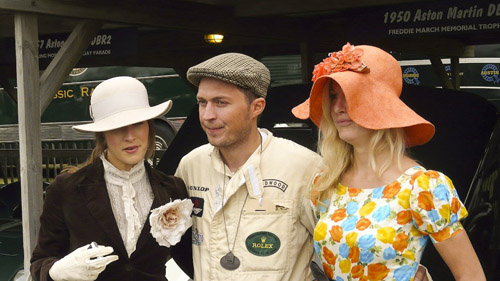
In his wake, Dick Attwood pondered his move and, uncharacteristically, it came in no-name corner, when the Dino partially took to the grass, catching ‘Stippy’ off-guard. The German tried to fight back but Attwood stylishly brought the Dino home safely. Eventually, Jochen Mass was a very distant third in the Lancia D50 recreation, having inched away from Barrie Baxter’s Tec-Mec in the closing stages. The Fordwater Trophy for production-based sports and GT cars of the sixties had its own stirring fight for the lead, as Ian Bankhurst’s TVR Grantura pushed Karsten Le Blanc in his Healey 3000 into a dramatic error the final time into Woodcote. Oh, the heartbreak…
Paddock and race pictures of the Richmond Trophy
Race pictures of the Fordwater Trophy
The most exciting lead battle probably took place in the Chichester Cup for front-engined Formula Junior cars. Usually not the most flamboyant cars on this fast circuit, the Juniors gave the spectators a real show in the second-to-last race of the weekend. Especially the lead trio of Derek Walker (Terrier-Ford), Mark Gillies (Lola-Ford) and Joe Colasacco (Stanguellini-Fiat) compensated their relative lack of speed with an unusually high fighting spirit, as they changed positions at almost every occasion right up to the flag. This was a thriller that often took your breath away. In contrast, the Freddie March Memorial Trophy turned into a rather straightforward affair for Darren McWirther’s Lagonda.
Practice and race pictures of the Chichester Cup
Practice and race pictures of the Freddie March Memorial Trophy
The number of crashes might have been limited this year, but that didn’t mean we often saw a full field at the finish line. There were several races of attrition in which engines were stretched beyond their limits, the opening Goodwood Trophy and the RAC TT Celebration being notable examples. The Goodwood Trophy race for early Grand Prix cars turned into another ERA benefit but not before race contenders John Ure, Duncan Ricketts (having started from the back) and Mark Gillies had fallen by the wayside in their respective B, E and A-types. But there were enough ERAs left to make it a podium clean sweep for Raymond Mays’s pre-war marque, Ludovic Lindsay in ‘Remus’ fending off a late challenge by Irishman Paddins Dowling.
Paddock, practice and race pictures of the Goodwood Trophy
The first part of the TT race was dominated by a fierce tussle between Jean-Marc Gounon’s Ferrari 250 GTO/64 and Adrian Newey’s E-type driven by Bobby Rahal. The pace of the two was such that they left a huge gap to the AC Cobra driven by Rob Hall and Emanuele Pirro in the Ferrari 330 LMB. Nearing the end of their stints, Rahal finally passed Gounon for the lead but the Frenchman hung on in the knowledge that his team mate Peter Hardman would easily have the measure of Adrian Newey.
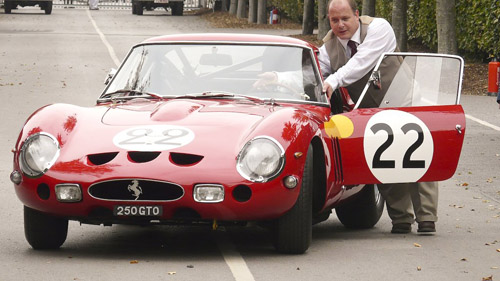
For a couple of laps after their pit stops this seemed to bear out as fact but then Hardman crawled into the pit, leaving Newey with a sizeable lead over Pirro’s co-driver Bobby Verdon-Roe. Initially, BVR upped his pace to gain two seconds a lap but Newey bravely responded and the gap remained at 16 seconds in the closing stages. Andy Wolfe – who received a very late call-up to join Rob Hall in the Cobra – finished a distant third, while the second half of the race claimed one mechanical victim after the other, including three E-types and the stunning 250 GT SWB ‘Breadvan’ that once was created for the Scuderia Serenissima. The one-off shooting-brake did have the most impressing exhaust note of all the GTs present in the race.
Paddock, practice and race pictures of the RAC TT Celebration
There were more stars in the two St. Mary’s Trophy races which this year entirely catered to cars of the Mini kind. Although it was somewhat of a disappointment to miss out on the cars it was used to fight – from Cortina to Fairlane, from Galaxie to Barracuda – the drivers made up for it in no mean amounts. While Oliver Gavin ran away with the spoils on Saturday, with an inspired Nick Swift using the same car to win on Sunday, Darren Turner was the real sensation of the first race, scything past car after car to eventually claim second place. In the Sunday race the second-to-sixth battle raged all the way to the finish.
Race pictures of the St. Mary Trophy
Another two-part event was the Barry Sheene Memorial Trophy. However, the motorcycle event wasn’t just split into two, it now also involved rider changes and a Le Mans start! On Saturday, Michaels Rutter and Russell spoiled the usual Wayne Gardner party, as the Australian for once failed to win, but on Sunday Gardner and his team mate John Lee Pemberton set the record straight. The two also claimed the overall win.
Practice and race pictures of the Barrie Sheene Memorial Trophy
The best-prepared cars with the best drivers again made the difference in the 1.5-litre F1 Glover Trophy. So no ‘Sharknose’ or Lotus 25 at the front – two period dominators, and now two very welcome additions to the field, the first a beautiful new replica in Belgian yellow, the second lovingly restored by Classic Team Lotus. Instead, Martin Stretton and Frank Sytner in their spaceframe Lotus 24s battled for victory, a battle that was decided early when a troubled Sytner began to fall away into the clutches of James King’s Brabham BT7 and Phil Keen’s 24. With typical Sytner luck, Frank saw his second place slip through his fingers in the final corner.
Paddock and race pictures of the Glover Trophy
There was yet more attrition in the one-hour, two-driver Lavant Cup for late-fifties World Championship sportscars. In the early stages Graham Dodd’s Tojeiro-Jaguar mixed it with Gary Pearson in Carlos Monteverde’s Lister-Jaguar, after pole-sitter Nick Leventis in his Ferrari 246S Dino had dropped back after a poor start. After the driver caroussel, Bobby Verdon-Roe having taken over from Leventis, the Dino stretched its legs to drive away to a very comfortable win from Barrie Williams in the Tojeiro. Frank Stippler, who brought Burkhard von Schenk’s RS61 back into contention, was among the retirements, as was Stirling Moss in his OSCA, who sadly was in and out of the pits more than setting any competitive time.
Paddock and race pictures of the Lavant Cup
Much of this year’s Revival meeting centered around the 80th birthday of Sir Stirling. Apart from the two mad motorcycle dashes it was hard seeking out a race that didn’t feature at least one of the 80 cars present to celebrate the fresh octogenerian. In effect, ‘Stirl’ was omnipresent the entire weekend. To top it off, the man himself led a parade around the circuit – choosing the Monaco-winning Lotus, with its famous drafty side-panel, on Friday and the Mercedes W196 on Saturday while he was driven round in a DBR1 on Sunday.
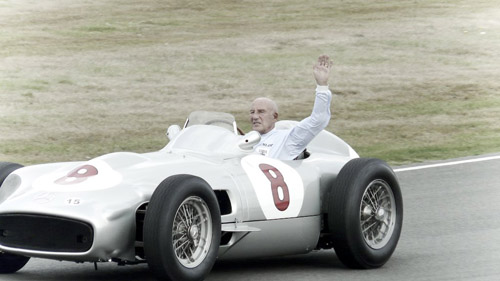
That third and final parade was followed by some touching words from Lord March, song from Lady March and a speech by the second man on the moon, Edwin ‘Buzz’ Aldrin, who was flown in with a ‘Huey’ helicoptre. Of course, ‘Buzz’ wished Stirling well, but it was hard to see any connection between the astronaut and the racing driver, however hard the American tried. When asked by Simon Taylor if he’d been to a historic race meeting before he tellingly answered: “I think they call it Indianapolis.” Let’s pray Tony George did not hear that.
We all come to Goodwood for the cars – to see them being man-handled in a real motor race but also to watch them up close and (almost) personal. Here are some of our most intimate shots of their man-made anatomy…
Goodwood Revival paddock detail
As usual, it isn’t just the cars and the bikes that make the show at the Goodwood Revival. It’s the planes as well, but above all the people. A record 134,000 of them this time, most of them donned in period dress. It’s what separates the Revival from any other historic event around the world and what also allows a significant number of ladies and children to be part of a motor racing spectacle that would otherwise be one of the usually male-dominated events. So let’s close with our photographic tribute to the unique atmosphere of the Goodwood Revival and the people who combine to create it.
Goodwood Revival atmosphere
